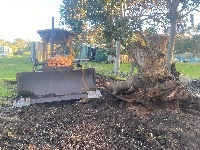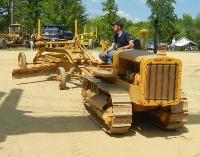- Posts: 739
- Thank you received: 195

ACMOC Membership Benefits
- FREE quarterly magazine filled with content about antique Caterpillar machines
- FREE classified listings
- ACMOC store discounts and specials
- Full Bulletin Board Access
- Marketplace (For Sale/Wanted)
- Technical Library
- Post attachments
$44 /year ELECTRONIC
$60 /year USA
$77 /year International
70D No. 12 wheel hub removal
The single axles Motor Graders did find a smaller niche in the market. Single axles would turn 🤣😂🤣 sharper (🤔 okay let us just say they had a tighter turning radius. An astounding 37.5 acres to turn around and not the traditional 40 acres 😉) They ruled in smaller and tighter areas, eventually the single axle found themselves in maintaining military bases and civilization municipalities. As an initiative equipment was given or sold to (at extremely low rates) State or boroughs that became incorporated.
In early WWI & WWII Military contracts were up for bid. Lots of industries had to build and fast. J: D. Adams, R. G. LeTourneau, David Boyd and his brothers (Galion Iron Works Co. c. 1907), Case, Holt and Best (Caterpillar), International Harvester and many many other well known equipment owners knew and would often bid agents one another on Military contracts. J. D. Adams and R. G. LeTourneau were friends through out WWI & WWII, Adams was eventually bought out by LeTourneau 🤔 in 1960.* *Yes it's heavy equipment there's always a caveat. Adams had previous contracts with the U.S. Army Corps of Engineers which LeTourneau honored and which still carried the Adams name.I have a picture of the last Adams ever made. Inspection/Manufacturer date 2/61.
So as we have seen here; Military contracts were a little behind the curve which by late 1945 early 1946 gave way to a gluttony of Military Surplus. Between Post WWII and Pre Stathood Alaska (1959) and Hawaii (1960) were found to be of vital national and global interest and seriously lacked infrastructure. Municipalities in Hawaii and especially Alaska were in desperate need of road building equipment and people to operate them.
In 1946, my Adams was sold to the Territory of Alaska and lived most of its professional life on the Keni Peninsula between Girdwood and Homer as ARC 971. Before DOT April 1st 1967, Alaska had the State equivalent called ARC (Alaska Road Commission). After Statehood in 1959, the 311 Adams had to be transferred from The Territory of Alaska to the State of Akaska so it had to be titled.
In 1960 was sold into Civilian life and spent several years in the glacial silt of Kasilof and then in the Matanuska-Susitna Valley.
On Adams the EOA35 (Engine Over Axle) were a married transfer case for single axles with Hi/Lo gear box. My 311's EOA35 was manufactured by Pacific Enterprises Los Angeles, (23) Calif. "👀 🤣🤣 address" the EOA50 were for tandem axles. The transmission and final drives on the 311 were from the 1937-1948 Oliver 80 Standard.
Might I digress 🤦.
ACMOC Member
Traxcavator: 60, 955E 12A08263; 57, 955C 12A04040; 57, 955C 12A03563.
1954 No.12 Diesel Motor Grader 8T14777.
1945 No.12 Diesel Motor Grader 9K9320; 9K9982
1944-46 Adams Model No. 311 Motor Grader
1943 IH T9 Tractor w/ Bullgrader Blade
Please Log in or Create an account to join the conversation.
ACMOC Member
Traxcavator: 60, 955E 12A08263; 57, 955C 12A04040; 57, 955C 12A03563.
1954 No.12 Diesel Motor Grader 8T14777.
1945 No.12 Diesel Motor Grader 9K9320; 9K9982
1944-46 Adams Model No. 311 Motor Grader
1943 IH T9 Tractor w/ Bullgrader Blade
Please Log in or Create an account to join the conversation.
May your pony always start. May the ground stays frozen so no sinking into the mud. Or what ever it takes to make you happy smoothing the trail for those that come after.
And to Mark may the pieces of the correct pulling/pushing gear appear to make your job possible without endangering yourself.
Please Log in or Create an account to join the conversation.
- Mark Riendeau
-
 Topic Author
Topic Author
- Offline
- Senior Boarder
- Member
- Posts: 73
- Thank you received: 13
Please Log in or Create an account to join the conversation.
- Mark Riendeau
-
 Topic Author
Topic Author
- Offline
- Senior Boarder
- Member
- Posts: 73
- Thank you received: 13
Please Log in or Create an account to join the conversation.
Please Log in or Create an account to join the conversation.
- Mark Riendeau
-
 Topic Author
Topic Author
- Offline
- Senior Boarder
- Member
- Posts: 73
- Thank you received: 13
Please Log in or Create an account to join the conversation.
I would snug it up daily, after about a week I came out to check in the morning and it was free, figured it was the heating and cooling along with the pulling.
Seems like there is two choices with some of those wheels, super tight or loose and all busted up.
Please Log in or Create an account to join the conversation.
I do like Josh's method though.
Please Log in or Create an account to join the conversation.
ACMOC
Antique Caterpillar Machinery Owners Club
1115 Madison St NE # 1117
Salem, OR 97301
support@acmoc.org
"I became a member recently because the wealth of knowledge here is priceless."
- Chris R
"I also joined a year ago. had been on here a couple of times as a non-member and found the info very helpful so I got a one year subscription (not very expensive at all) to try it out. I really like all the resources on here so I just got a three year. I think its a very small price for what you can get out of this site."
- Jason N




